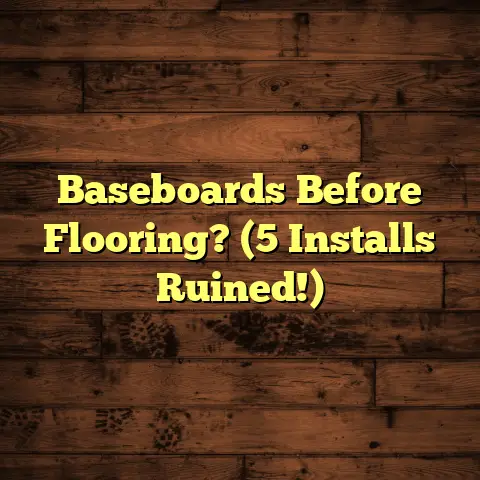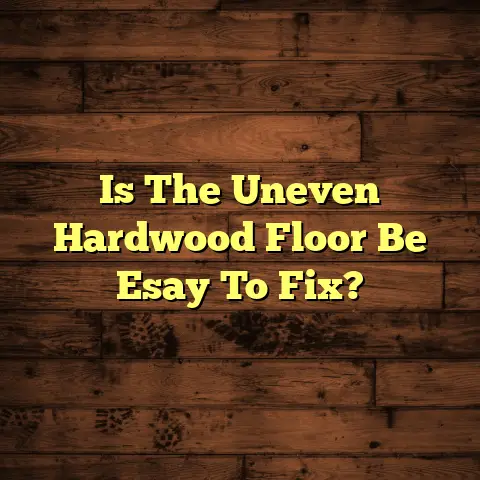Best Floor Pads For Furniture? (3 To Avoid!)
Choosing the right floor pads for your furniture can mean the difference between maintaining pristine floors and facing costly damage.
I’ve seen it happen too many times: beautiful hardwood floors marred by scratches from unprotected furniture legs.
But floor pads aren’t just about protecting your floors; they also enhance the longevity of your furniture and improve your home’s overall look and feel.
Let’s dive into the world of floor pads, separating the good from the bad, and help you make the best choices for your home.
Section 1:
Understanding Floor Pads
What exactly are floor pads?
Simply put, they’re protective barriers
placed between your furniture and your floors.
Their primary goal?
To prevent scratches,
dents, and other types of damage
caused by friction and weight.
I use them religiously on every project I do, and I always advise my clients to do the same.
Types of Floor Pads
You’ve got a few main options here:
-
Felt Pads:
These are probably the most common.
They’re soft, relatively inexpensive,
and work well on hardwood, laminate,
and tile.I find that the adhesive-backed ones
are best for lighter furniture. -
Rubber Pads:
Rubber pads offer excellent grip,
making them ideal for furniture
that tends to slide around.They’re also good for heavier pieces.
I often use these under couches
and chairs. -
Plastic Pads:
These are less common in residential
settings but can be useful on carpets
to help furniture slide more easily.However, I generally avoid them
on hard surfaces as they can
sometimes cause scratching. Cork Pads:
Cork pads are a more eco-friendly
option.
They offer good cushioning
and are naturally slip-resistant.I like using these in homes where
sustainability is a priority.
Materials and Their Impact
The material of your floor pad directly affects its performance and durability.
Felt pads, for example, are made from
wool, synthetic fibers, or a blend of both.
Higher-quality felt pads made with denser
wool will last longer and provide better
protection than cheaper, thinner options.
Rubber pads can be made from natural
or synthetic rubber.
Natural rubber
tends to be more durable and offers
better grip, but it can also be more expensive.
Plastic pads are typically made from
polyethylene or polypropylene.
These are durable but can be too rigid
for some surfaces.
Section 2:
The Importance of Choosing the Right Floor Pads
Think of your floors as an investment.
Choosing the right floor pads is like
insurance – it protects that investment
from unnecessary wear and tear.
Impact on Different Flooring Types
Hardwood:
This is where floor pads are absolutely
essential.
Scratches on hardwood
are difficult and costly to repair.Felt or rubber pads are your best bet.
I always recommend using high-quality
felt pads with a strong adhesive.-
Tile:
Tile is more durable than hardwood,
but it’s not immune to damage.
Dragging furniture across tile can
cause scratches and even chips.Rubber pads are great for preventing
slippage on tile, while felt pads
can protect against scratches. -
Laminate:
Laminate flooring is susceptible
to scratches and dents, much like
hardwood.Use felt pads to protect it.
I’ve seen too many laminate floors
ruined by unprotected furniture. -
Vinyl:
Vinyl flooring can be scratched
or torn by sharp furniture legs.
Felt or rubber pads work well here.Be careful with plastic pads,
as they can sometimes leave marks.
Preventing Damage
Floor pads act as a buffer, preventing direct contact between furniture legs and the floor.
This prevents scratches, dents, and other damage that can occur when furniture is moved or slides across the floor.
I can’t tell you how many times I’ve seen people move a couch without pads and leave a trail of scratches in its wake.
Reducing Noise and Improving Mobility
Beyond protection, floor pads can also
reduce noise.
The scraping sound of
furniture being moved is annoying,
to say the least.
Pads dampen that noise, creating a quieter home environment.
Additionally, the right pads can make
it easier to move heavy furniture.
This is especially helpful when
rearranging rooms or cleaning.
Section 3:
Best Floor Pads for Furniture
Alright, let’s get down to specifics.
Here are some of the best floor pads
I’ve used and recommend:
X-PROTECTOR Premium Felt Pads
These are my go-to for most projects.
The adhesive is strong, and the felt
is thick enough to provide good protection.
-
Key Features and Benefits:
Extra-strength adhesive ensures
the pads stay in place.
Available in various sizes and shapes
to fit different furniture legs. -
Pricing Information:
Around $10-15 for a pack of various sizes. -
User Reviews and Ratings:
Typically rated around 4.5/5 stars.
Users praise the strong adhesive
and durability. -
Ideal Use Cases:
Best suited for hardwood, laminate,
and tile floors.
Ideal for light to medium-weight furniture
like chairs, tables, and sofas.
Scotch Self-Stick Floor Protectors
A reliable brand with a solid reputation.
These pads are easy to apply and provide
decent protection.
-
Key Features and Benefits:
Durable felt material.
Easy self-stick application. -
Pricing Information:
Around $8-12 for a pack. -
User Reviews and Ratings:
Typically rated around 4/5 stars.
Users appreciate the ease of use
and reasonable price. -
Ideal Use Cases:
Great for hardwood and tile floors.
Best for light furniture.
Shepherd Hardware Rubber Leg Tips
For heavier furniture, rubber leg tips
are the way to go.
They provide
a secure grip and prevent sliding.
-
Key Features and Benefits:
Secure fit to prevent slipping.
Durable rubber material. -
Pricing Information:
Around $12-18 for a pack. -
User Reviews and Ratings:
Typically rated around 4.2/5 stars.
Users like the non-slip properties
and secure fit. -
Ideal Use Cases:
Perfect for heavy furniture like couches,
chairs, and tables.
Works well on hardwood, tile, and laminate.
Slipstick CB844 Hard Surface Floor Protectors
These are a bit pricier, but they’re
designed for heavy-duty use.
They’re low-profile and blend in well
with furniture.
-
Key Features and Benefits:
Heavy-duty construction.
Low-profile design. -
Pricing Information:
Around $20-25 for a set of 4. -
User Reviews and Ratings:
Typically rated around 4.6/5 stars.
Users rave about their durability
and effectiveness. -
Ideal Use Cases:
Best for heavy furniture on hardwood
and tile floors.
Furniture Pads by Marktek
If you need something customizable,
Marktek’s pads are a great option.
They offer high-density felt that can be
cut to fit any shape.
-
Key Features and Benefits:
High-density felt material.
Customizable shapes and sizes. -
Pricing Information:
Around $15-20 for a pack. -
User Reviews and Ratings:
Typically rated around 4.3/5 stars.
Users appreciate the versatility
and quality of the felt. -
Ideal Use Cases:
Suitable for various furniture types
and DIY projects.
Section 4:
Floor Pads to Avoid
Not all floor pads are created equal.
I’ve encountered some that are simply
a waste of money, and some that can
even cause damage.
Here are three types or brands to avoid:
Cheap, Thin Felt Pads:
These are often sold in bulk at
discount stores.
They’re tempting
because of the low price, but they
wear out quickly and offer minimal protection.-
Plastic Pads on Hardwood:
As I mentioned earlier, plastic pads
can scratch hardwood floors.
Avoid using them on these surfaces. Pads with Weak Adhesive:
Pads that don’t stick properly are
useless.
They’ll slide off, leaving
your floors unprotected.
Cheap, Thin Felt Pads
-
Name of the Product:
Generic, unbranded felt pads. -
Reasons to Avoid:
Poor durability.
Ineffective at protecting against scratches. -
User Experiences and Common Complaints:
“They fell off after a week!”
“They’re too thin to provide any real protection.” -
Alternative Suggestions:
Invest in higher-quality felt pads
from a reputable brand like X-PROTECTOR
or Scotch.
Plastic Pads on Hardwood
-
Name of the Product:
Generic plastic floor pads. -
Reasons to Avoid:
Can scratch hardwood floors.
Too rigid for hard surfaces. -
User Experiences and Common Complaints:
“They left scratches on my new hardwood!”
“They don’t grip well and slide around.” -
Alternative Suggestions:
Use felt or rubber pads instead.
These are much gentler on hardwood.
Pads with Weak Adhesive
-
Name of the Product:
Off-brand adhesive felt pads. -
Reasons to Avoid:
Poor adhesion.
Fall off easily. -
User Experiences and Common Complaints:
“The adhesive is terrible – they won’t stay on!”
“I had to replace them constantly.” -
Alternative Suggestions:
Look for pads with extra-strength adhesive
or consider using nail-on pads for
a more secure attachment.
Section 5:
How to Choose the Right Floor Pads
Choosing the right floor pads is all about matching the pad to the furniture and the flooring.
Factors to Consider
-
Type of Flooring:
As we’ve discussed, different flooring
types require different pads.
Hardwood and laminate need soft felt
pads, while tile can handle rubber or felt. -
Weight and Type of Furniture:
Heavier furniture requires more durable
pads with a strong grip.
Lighter furniture can get away with
simpler felt pads. -
Desired Aesthetics and Color Matching:
Floor pads come in various colors.
Choose pads that blend in with your
furniture or flooring for a seamless look.
Measuring Furniture Legs
Accurate measurements are crucial.
Measure the diameter or dimensions of
your furniture legs to ensure a proper fit.
Too small, and the pad won’t provide
adequate protection.
Too large, and they’ll look awkward
and might not stay in place.
Section 6:
Installation and Maintenance of Floor Pads
Proper installation and maintenance are key to maximizing the lifespan and effectiveness of your floor pads.
Step-by-Step Installation Guide
-
Clean the Furniture Legs:
Use a damp cloth to clean the bottoms
of the furniture legs.
Make sure they’re dry before applying
the pads. -
Peel and Stick:
Remove the backing from the adhesive
side of the floor pad. -
Apply Firmly:
Center the pad on the bottom of the
furniture leg and press firmly for
several seconds to ensure a secure bond. -
Test:
Gently test the pad to make sure
it’s securely attached.
Maintenance Tips
-
Regular Checks:
Periodically check the pads for wear
and tear. Replace them as needed. -
Cleaning:
If the pads get dirty, gently wipe
them with a damp cloth. -
Re-Adhesion:
If the adhesive starts to weaken,
consider replacing the pads or using
a stronger adhesive.
Section 7:
Conclusion
Investing in quality floor pads for your furniture is a small price to pay for the protection and longevity of your flooring and furniture.
I’ve seen firsthand the damage that can be caused by neglecting this simple step.
So, take a look at your current floor pads.
Are they providing adequate protection?
Are they the right type for your flooring
and furniture?
If not, it’s time to make an upgrade.
Your floors (and your furniture) will
thank you for it.
Don’t wait until you see scratches and dents – be proactive and protect your investment today!





